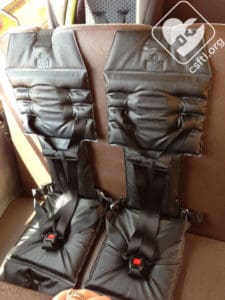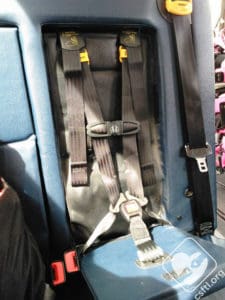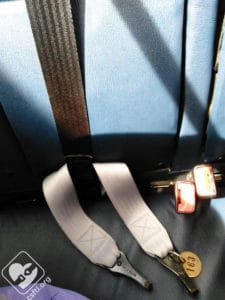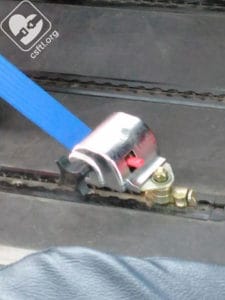For much of North America, a big yellow bus means kids are going to school — at the start of the school year, that bus pulling up to the curb can be a big relief! Putting a school age Little on the bus for the first time can be stressful for lots of reasons, but in general, parents can rest assured that yellow buses are a very safe way to get kids from home to school and back again. We’re going to outline how buses protect kids, what kinds of buses are on the roads, some restraints you might find in buses for the littlest of Littles and what kids and adults can do to stay safe inside and outside yellow buses.
Yellow Buses: The Safest Way to Get Schooled
As with all child passenger safety, paying attention to details matters when we’re trying to keep Littles safe on the bus. Buses are very safe when used correctly — just like properly used child restraints in cars. NHTSA concludes, from comparing the number of deaths and injuries involving school-age children in cars and the number of deaths and injuries involving school buses, that riding the bus is 8 times safer than arriving at school in a car.
Why School Buses are Safe
School buses are so safe because they are designed quite differently from passenger vehicles. They are strong and large, very easily visible, driven by specially trained drivers on known routes and subject to special traffic laws. This is why it’s important to never pass a school bus with the lights on, no matter how late you may be to work or other activities. The most surprising difference (at least to CSFTL’s safety-conscious readers) is that school buses protect children very well even without harnesses or, most of the time, seat belts.
Compartmentalization
School buses protect children’s bodies without harnesses or seat belts with a design called “compartmentalization.” When sitting properly in school bus seats, passengers on a school bus are protected like eggs in an egg crate. The space around them is designed to support them in a crash.
Compartmentalization is the reason big yellow school buses have tall seat backs and not much room for an adult’s knees. Should the bus stop suddenly, as in a crash, the child’s body is expected to move forward and possibly impact the seat in front. This is what that seat was designed for, and it does a good job of protecting school-age bodies. Those bodies need to be in the proper position at all time. As parents we can remind our children to take off their back packs and stow them at their feet and always sit in the bus’s seat when the bus is moving. In other words: no running around shenanigans on the way to or from school.
Some school buses will have seat belts. They are required in six states, and in November, 2015 NHTSA announced that they will begin a new multi-faceted campaign for school bus safety. One of the goals of this campaign is that all children have lap-shoulder belts on yellow buses. We at CSFTL are thrilled to support increasing the future safety of children on school buses, but we also agree with NHTSA that current school buses are still the safest way to transport kids to and from school. Join us in advocating for seat belts on school buses but don’t hesitate to send your kids to school on the bus in the meantime.
Different Sizes and Types of Buses
School buses are not one size fits all. Buses come in different sizes, and these different classes of buses are required to carry different safety equipment. Buses are classed according to weight: a bus that weighs under 10,000 lbs is a “small” bus and it must have seat belts. However, these buses are comparatively rare and parents are unlikely to encounter them. Nearly all the buses on the roads doing daily transport for school-age children are large yellow buses.
Preschool aged children or those who have special needs, or children going on special trips are often transported in yellow vehicles that are usually quite a bit smaller than the large yellow buses we think of doing daily routes. These buses (called Multi Use Activity Vehicles) meet nearly all the same federal guidelines as large buses. This type of bus must be equipped with seat belts.
Child Restraints: Required For Preschool Age Children
Though school age children are well protected in large school buses, they are not the only children who are transported in buses. Children younger than school age always need child restraints of some kind, either a harness built in to the school bus itself, or a traditional car seat fitted to the bus with the bus’s own seat belts, much as a car seat is installed in a vehicle.
Unfortunately, not all seat belts on all buses are appropriate for installing a child restraint. Some may not be compliant with federal standards, and some may have buckle stalks that extend so far that car seats are incompatible. If your under school age child is going to ride on a bus you’ll first want to make sure that the bus she is riding on has the proper equipment.
Rear Facing on the Bus
As in cars, rear facing is the safest way to ride. Babies are only rarely transported by school bus, but when they are they will need to ride rear facing as in the car. Older children can ride in their conventional car seats, in a harness specially made for school buses, or in a restraint specifically made for smaller children that is integrated into the bus seat itself. As with car seats, any restraint is only safe if used correctly every time; it is essential that the bus driver or caregiver buckling and riding with the child follow the manual for the specific restraint used.

Forward facing car seat installed on a school bus. Image courtesy of NHTSA Image Library.
Most children who will need child restraints on school buses are children who are old enough to ride forward facing, but too young to be properly protected by the bus’s own compartmentalization. Some school buses have reinforced seats that are fitted with seat belts or LATCH lower anchors to install conventional car seats. Installing and using conventional car seats in this type of bus is much like installing them in the car, though for conventional seats in a bus you do not use a top tether.
Some school buses are fitted with integrated seats. These seats feature five point harnesses that are often stored behind a fold-down panel. The harness must be adjusted to the height of the child for every ride.
Some school bus specific child restraint systems are attached to the bus not by a seat belt or tether, but by a cam wrap which uses the back of the seat itself to install the restraint. There are a few different kinds of these restraints: they can look like a vest that the child puts on prior to boarding the bus or like harness that stays in the bus and that the child buckles into. As with all safety restraints the weight and height limits and the instructions for the specific product being used need to be followed for every ride.
It’s essential for preschool age kids to be in a restraint of some kind, and that that restraint be used properly. There are many different possible restraints, all with their own rules. Follow the restraint’s manual to properly adjust the seat for the child on every single ride.
Children with Special Needs
Children with special physical needs, too, are transported on school buses. Some of the same harnesses that preschoolers use on buses are used for older children who require more support than just the school bus seat. The safest way to ride in a school bus is on the bus’s own seats: children in wheelchairs should only ride in their wheelchair on the bus if transferring them is not an option. If they do ride in their wheelchairs on the bus, wheelchairs, the bus and tie-downs in the bus all need to be compliant for this kind of use. Wheelchairs should always be facing the front of the bus, properly affixed to the bus and children must always also be secured in a seat belt. These situations are complex and often misunderstood; a special needs trained CPST could help caregivers, transportation coordinators and bus companies plan for the safe transport of children no matter their physical abilities.
Pedestrian Safety
Between 2003 and 2013, most of the people who lost their lives in accidents involving school transportation (71%) were people riding in other vehicles. Pedestrians and bicyclists accounted for the next largest group of fatalities in school transportation-related crashes (21%). For parents who send their kids on the bus these numbers tell us that when we look to how our children can be safer, we need to look outside the bus itself, to the part of the journey where children are pedestrians.

Image courtesy of NHTSA Image Library.
There are some simple ways we can make kids safer around the outside of buses. Getting to the bus stop early is one (we all know how mornings with kids go, but in this case not rushing is a safety issue; it’s worth doing everything you can to get there 5 minutes early). Standing 6 feet back from the approaching bus is good to teach kids, as is always crossing 10 feet in front of the bus, where you can see the driver, and never crossing behind a bus. Remind children never to lean down into the road if they’ve dropped their back packs: they should tell the driver rather than lean down where their small bodies are more difficult to see.
As drivers, we can make pedestrians and cyclists safer, too. Being very careful when leaving a driveway in the morning is essential, whether you are backing up or driving out forward. When backing up I always roll my window down in case I can hear the hazard I can’t see (I figure it can’t hurt and it might save my own kid’s life). As drivers we should know the school bus rules and the school zones on our routes and obey all speed limits, but especially those in school zones. And, as always, we should stay alert: children who are late to school, like adults late to work, tend to dart out unexpectedly.
In short, for kids who are old enough for formal school, with or without a seat belt, school buses are a very safe form of transport. Teaching your kids to sit properly in the bus seat at all times, helping your children to be safe pedestrians around the outside of the bus, driving carefully in school zones and observing school bus traffic laws are the best steps you can take to protect your bigger Littles as they go off into the world.









